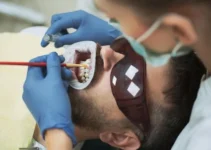An interdental toothbrush is an essential tool for maintaining oral health, particularly in cleaning those hard-to-reach spaces between your teeth. Regular toothbrushes often miss these narrow gaps, which are susceptible to plaque buildup and gum disease. By incorporating an interdental toothbrush into your daily dental care routine, you can significantly reduce the risk of cavities and gingivitis. This article explores how to effectively use interdental brushes, various types available, and the benefits they offer in preserving your dental health.
What is an Interdental Toothbrush?
An interdental toothbrush is a dental hygiene tool designed specifically to clean between the teeth, where regular toothbrushes cannot reach. These brushes are particularly effective in removing plaque and food particles lodged in the interproximal spaces, which helps prevent cavities and gum disease. Their unique design enables users to maintain a higher level of oral hygiene, contributing to overall dental health.
The use of interdental toothbrushes is recommended for individuals with orthodontic appliances, braces, bridges, or even those who have larger gaps between their teeth. Regular usage can significantly reduce the risk of periodontal diseases and improve the effectiveness of daily oral care routines.
Studies have shown that interdental brushes can remove up to 40% more plaque compared to flossing alone. Their bristles can reach into the concavities and irregularities that floss might miss. Therefore, incorporating an interdental toothbrush into your oral hygiene routine can lead to healthier gums and stronger teeth.
Definition & Design
An interdental toothbrush comprises a small, cylindrical brush head designed to fit into the tight spaces between your teeth. The brush head is usually attached to a short, angled handle, making it easy to hold and maneuver. The bristles are often made of soft, flexible material to prevent damage to the gums and provide efficient cleaning.
The design of an interdental toothbrush is crucial for its effectiveness. The brush’s size and shape should be chosen based on the size of the interdental spaces. For example, people with larger gaps between their teeth may need a brush with a broader head, while those with smaller gaps might benefit from a narrower one. The handles can also vary in length and flexibility, accommodating different user preferences and needs.
Interdental brushes are also designed to be durable yet gentle. The bristles are usually arranged in a spiral pattern around a thin wire, which allows them to compress and fit into tight spaces, then expand to clean thoroughly when withdrawn. This unique brush structure ensures maximum plaque removal without causing undue discomfort.
Types of Interdental Toothbrushes
There are several types of interdental toothbrushes available, catering to different dental needs and preferences. Common types include:
- Tapered Brushes: These have a cone-shaped head and are ideal for cleaning tight spaces and around braces or dental bridges.
- Cylindrical Brushes: These have a straight, uniform head and are suitable for general use, particularly effective for individuals with evenly spaced teeth.
- Angled Brushes: Designed with a bendable neck, these brushes are perfect for reaching the back teeth and other hard-to-access areas.
Choosing the right type of interdental toothbrush depends on various factors, including the size of the interdental spaces, the presence of dental work like braces or bridges, and personal comfort. It is often recommended to consult with a dental professional to determine the most suitable type for your specific needs.
Additionally, interdental toothbrushes come in different sizes, indicated by color codes in many brands. These sizes range from very fine to larger diameters, ensuring that there is an appropriate option for every individual. Regularly using the correct size brush can help maintain optimal oral hygiene and prevent dental issues.
Benefits of Using an Interdental Toothbrush
The use of an interdental toothbrush offers numerous benefits for oral health. These small brushes are designed to clean the spaces between your teeth, an area that traditional toothbrushes often miss. Incorporating an interdental toothbrush into your daily oral hygiene routine can dramatically improve your overall dental health.
One of the most significant advantages is the ability to reach and clean those hard-to-access areas between teeth, where plaque and food particles commonly build up. By efficiently cleaning these spaces, an interdental toothbrush helps to prevent various dental issues and maintain a healthy mouth.
Additionally, using an interdental toothbrush can enhance the effectiveness of other oral hygiene practices. When combined with regular brushing and flossing, these tools can contribute to a more comprehensive approach to oral care, making sure no area is overlooked.
Enhanced Oral Hygiene
Using an interdental toothbrush can significantly enhance your oral hygiene routine. These brushes are uniquely designed to fit into the tiny gaps between your teeth and remove food particles and plaque that a regular toothbrush might miss. This ensures that your mouth stays clean and reduces the risk of cavities and other dental issues.
Studies have shown that incorporating an interdental brush into your daily routine can lead to better gum health and reduced gingivitis. By targeting areas that are often neglected, you are more likely to maintain healthy gums and avoid the discomfort associated with gum disease.
Here are some ways an interdental toothbrush can enhance your oral hygiene:
- Improved removal of debris and food particles
- Reduction in plaque buildup
- More effective cleaning between braces, bridges, and implants
Prevention of Gum Disease
The regular use of an interdental toothbrush can be a powerful tool in the prevention of gum disease. Gum disease, or periodontal disease, begins with plaque buildup along the gumline. If not removed, this plaque hardens into tartar, which can cause inflammation and infection in the gums.
An interdental toothbrush is specifically designed to clean the areas where plaque tends to accumulate but is often missed by traditional brushing and flossing. By removing plaque from these critical areas, you can significantly reduce your risk of developing gum disease.
There are several types of gum disease, ranging from mild gingivitis to more severe periodontitis. Regular use of an interdental brush can help prevent the progression of these conditions by maintaining a clean and healthy gumline.
For those already battling gum disease, incorporating an interdental toothbrush into your daily routine can help manage and potentially reverse the condition.
Plaque Reduction
Plaque is a sticky film of bacteria that forms on your teeth and gumline. If not removed regularly, plaque can lead to dental problems such as tooth decay and gum disease. An interdental toothbrush is highly effective in reducing plaque buildup, especially in areas that are difficult to reach with a standard toothbrush and floss. By using an interdental toothbrush daily, you can ensure a more complete removal of plaque, which ultimately leads to fresher breath and a healthier mouth. Plaque reduction is crucial in preventing cavities and promoting overall dental health.
Studies have demonstrated that individuals who use an interdental toothbrush in addition to regular brushing and flossing have lower plaque levels and healthier gums compared to those who do not. This extra step in your oral care routine can make a significant difference in the long-term health of your teeth and gums. For a detailed understanding of how to best incorporate interdental brushes into your oral hygiene routine, consider reading some of our other articles on advanced dental care techniques and products.
How to Use an Interdental Toothbrush
Interdental brushes are a highly effective tool for maintaining oral hygiene. They are especially useful for cleaning the spaces between your teeth where a regular toothbrush might not reach. Using an interdental toothbrush can help prevent gum disease, cavities, and other dental issues by removing food particles and plaque. In this article, we will provide a comprehensive guide on how to use an interdental toothbrush properly.
It’s important to understand that different people might require different sizes of interdental brushes. The size needed typically depends on the gaps between your teeth, so it’s a good idea to consult your dentist for advice on which size to use. With proper usage, interdental brushes can significantly improve your oral health, making them a valuable addition to your dental care routine.
Step-by-Step Guide
Using an interdental toothbrush is straightforward once you get the hang of it. Here is a step-by-step guide to help you maximize its benefits:
- Choose the Right Size: Select an interdental brush that fits comfortably between your teeth. It shouldn’t require force to insert and should move smoothly.
- Insert the Brush: Gently insert the brush into the space between your teeth. Be careful not to push too hard as this could harm your gums.
- Move the Brush: Move the brush back and forth a few times to clean the area. Ensure you reach both the front and back sides of the teeth.
- Rinse the Brush: After using the brush, rinse it under water to remove any debris. Replace the brush when it starts to show signs of wear.
- Repeat: Continue this process for all the spaces between your teeth. Make sure to follow the same steps for each gap.
Even though these steps are simple, it’s crucial to perform them with care to avoid damaging your gums. When used correctly, interdental brushes can significantly enhance your oral hygiene routine.
Common Mistakes to Avoid
While using an interdental brush can be straightforward, there are common mistakes that many people make. Being aware of these pitfalls can help you use the tool more effectively:
- Using the Wrong Size: One of the most common errors is using a brush that is too large or too small. This can either damage your gums or fail to clean effectively.
- Forcing the Brush: Never force the brush into a space. If it doesn’t fit easily, you might need a smaller size.
- Neglecting Regular Replacement: Like any toothbrush, interdental brushes wear out. Make sure to replace them regularly to maintain their effectiveness.
- Skipping Certain Areas: Ensure you don’t skip any interdental spaces in your mouth. Consistency is key for comprehensive oral hygiene.
- Not Consulting a Dentist: Always consult your dentist for advice on the best practices and the right size for your specific needs.
By avoiding these common mistakes, you can make the most out of your interdental brushes and keep your oral health in top shape.
If you found this article helpful, be sure to check out our other articles for more tips and information on maintaining excellent dental health.
Frequently Asked Questions about Interdental Toothbrushes
Understanding how to use interdental toothbrushes correctly can enhance oral hygiene significantly. Here are some commonly asked questions to help clarify their benefits and usage.
How does an interdental toothbrush differ from a regular toothbrush?
An interdental toothbrush is designed to clean between the teeth and around braces, where regular toothbrushes might not reach effectively. Its small bristled head fits snugly in tight spaces, allowing for removal of plaque and food particles, helping to prevent gum disease and cavities.
How often should I use an interdental toothbrush?
It is recommended to use an interdental toothbrush once a day, ideally in the evening after regular tooth brushing. This helps to ensure that all food particles and plaque buildup are removed from between your teeth, contributing to overall dental health.

My name is Salman Kapa, a 73-year-old expert in bone regeneration and dental implantology. With decades of experience in the field, I am dedicated to advancing our understanding of oral health and hygiene. Through my research and writing, I aim to contribute to the development of innovative solutions in dental care.




